Kinderdijk was the first place that I visited in Netherlands. Aside from stepping out in Den Haag for an hour or two after our flight landed that is. I call it my introduction to Europe. Shawn thinks it is the place that stole my heart and he isn’t very wrong there. Kinderdijk is gorgeous, perfect and romantic.
It’s definitely one of my favorite places in Netherlands and that is saying something because I love the country and the people with a passion that even the Dutch find astounding. In fact it is one of those places you can head to to avoid the crowds and relieve your stress in Europe.
I digress… Let’s get back to the topic at hand… Kinderdijk! It is beyond doubt one of the best places to visit in the Netherlands.
This post may contain affiliate links. As an Amazon Associate, I earn a small commission from qualifying purchases at no additional cost to you. Read my disclaimer for further information.
Table of Contents
Kinderdijk
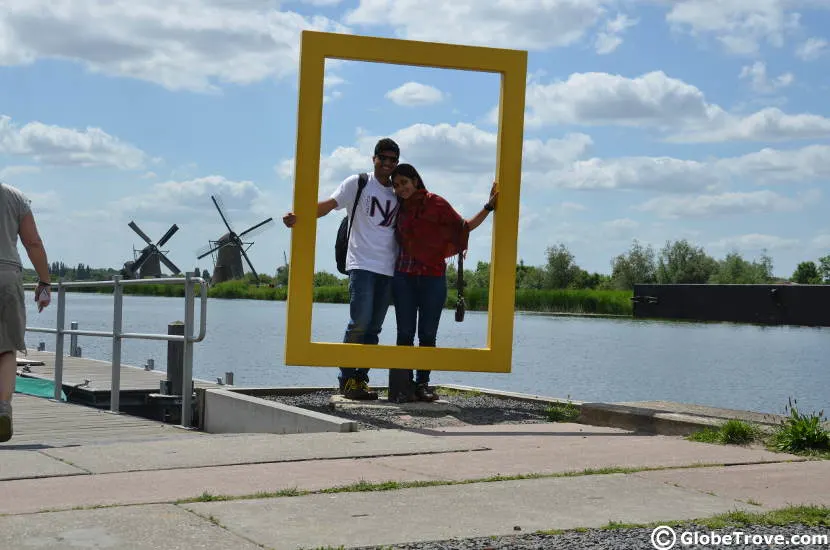
The Nat Geo sign at Kinderdijk demands a pose.
Today Kinderdijk is a UNESCO Heritage site that has stood the test of time and remains a testament to how well the Dutch community manages its water issues.
While many countries across the world battle with scarcity of water, Netherlands has a unique problem. It has too much water. Always had and potentially will. Kinderdijk (like so many parts of Netherlands) lies below sea level.
But unlike other places that lie below sea level, you don’t require snorkelling or scuba gear.
Update: I’ve been back to the same spot in March 2025 and the Natgeo sign is unfortunately no longer there.
What is Kinderdijk famous for?
If you ask any tourist who has done their research on the Netherlands, they will tell you that Kinderdijk is famous for windmills.
The scenic view which became really popular after National Geographic did a feature on the UNESCO site. There is however more to that than meets the eye since windmills area symbol of the Dutch ingenuity.
The Kinderdijk area has been kept dry and has been cultivated due to the ingenious use of canals, windmills and pumping stations. When you visit Kinderdijk you can’t help but think about the rising oceans and climate change.
While the Dutch water systems are amazing and brilliant, you can’t help but wonder how long they will work if global warming is not reversed.
That being said, the story behind Kinderdijk goes back hundreds of years. While the mechanism of pumping out water from the ground has been refined and developed, the concept has been around for a long while.
Things To Do In Kinderdijk
We were rather surprised at the number of things that one can do in Kinderdijk. The multiple activities make Kinderdijk a great place to visit provided the weather holds up its end of the bargain. While we did not indulge in all the activities, we are just going to list them so that you know they exist and you can plan your trip better than we did.
- Visit the museums
- Take a boat and enjoy the countryside in true Dutch style.
- Cycle paths are plentiful, so it doesn’t come as a surprise that cycling around Kinderdijk is popular too.
- Walk leisurely through the countryside enjoying the peace and quiet. You can even have a nice picnic.
- Catch a quick bite to eat at the outdoor patio.
- Go on a short trek through the countryside.
- Rent a cycle and enjoy the Dutch cycling paths.
- Have a picnic.
The Windmills At Kinderdijk: A UNESCO Heritage Site
Did you know that the windmills at Kinderdijk are a part of a UNESCO heritage site? It is one of the best maintained heritage sites I have ever been to. This is saying something if you consider the expanse of land that the site covers.
19 gorgeous windmills built way back in the 1700s dot the landscape. While they are symbolic today, back then they played an important part in keeping the low lying lands of Alblasserwaard from flooding. The entire tour of the area will show you how the Dutch have moved to a gas powered system to manage the water levels in the area.
Windmills at Kinderdijk Tickets
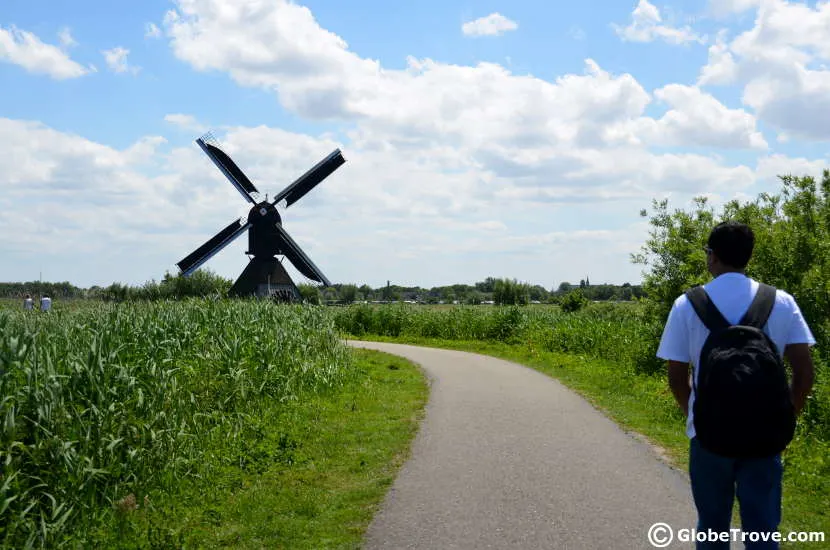
⭐️ Rating: 4.6/5 (295 Reviews) Price: $17.45 per person Duration: 4 hours Details: Read more on Get Your Guide Now!
Tickets to visit the UNESCO Heritage site can be obtained online. The current cost of the ticket is $17.45 per person. We were able to purchase tickets from the ticket office on site which is a bit more costly. The ticket also provides access to the Blokweer, Nederwaard and Wisdom Pump museums which are worth seeing.
“Very nice activity, small flat everything is in English but that does not spoil the fun! You can take a nice walk along the canals and discover the interior of several mills, it’s magnificent!”
Nadège (read more reviews now!)
If you aren’t aware about how the Dutch water pump system works (and even if you do), we would suggest visiting the Wisdom Pump museum before heading to the other parts of the site. It will give you a bit of history and a bit of knowledge of how the function of the windmills and the dykes works.
How To Get To The Windmills At Kinderdijk
Kinderdijk is an easy road trip from most places in Netherlands largely because of its good transportation system. Its approximately 97 kms away from Amsterdam, 62 kms away from Utrecht, 24 kms from Rotterdam and 52 kms from Den Haag. It is easily accessible by road and by local transport.
Wisdom Pump Museum
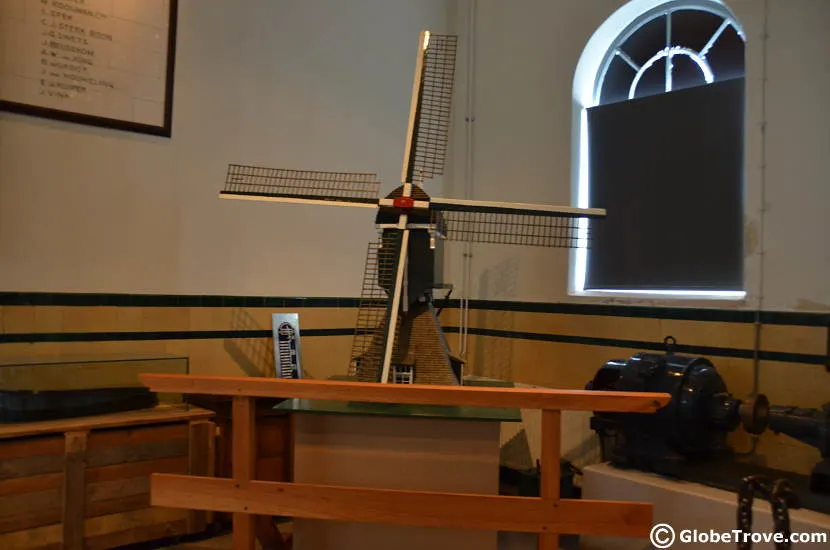
A model of the windmills that was setup in the museum.
The Wisdom Pump Museum is a great place to start off. There is a short video explaining why the drainage of the land in the vicinity is so important. The original settlers stayed on the sand dunes in the area. As time progressed, the need to cultivate land increased.
The entire expanse of Kinderdijk was mostly submerged under water and was technically a bog. The rivers and the sea competed for its terrain. Cultivating the area seemed almost impossible especially since it was accessible only in summer and that too if and only if the water levels were low.
In order to cultivate the land, the settlers of Kinderdijk built dykes. To do this, they built dykes that kept the sea water. Their problems however were far from solved. Rain water and ground water kept the vicinity submerged making agricultural development difficult.
The challenge was to drain the water out of the land and to ensure that the draining mechanism worked continuously so that Kinderdijk did not get submerged once more.
The Dutch then harnessed the wind and the water to work to their advantage. With an intricate system of canals and windmills, the water was pumped out of the land making it habitable. The fertile plain then served as a great place to cultivate crops.
The life of these initial settlers however was hard. Managing the windmills was a full-time chore. If the windmills failed, it meant that the area would flood, and their livelihood would be washed away.
In addition to managing the windmills, they needed to tend to the crops to ensure that they had enough food for their families. The cold, rain and poverty did not help them either. It only served to make their life increasingly difficult. That however is something that can be seen in the other museums on the site.
The wind energy was later supplement by steam pumps and today, Kinderdijk is kept dry due to the electric pumps that are in use. These pumps are faster and more efficient than the windmills.
The windmills of Kinderdijk however are maintained and still kept in use. Making the entire site surreal and beautiful. I highly doubt that there is another windmill complex like Kinderdijk elsewhere in the world.
Why Is It Called Kinderdijk?
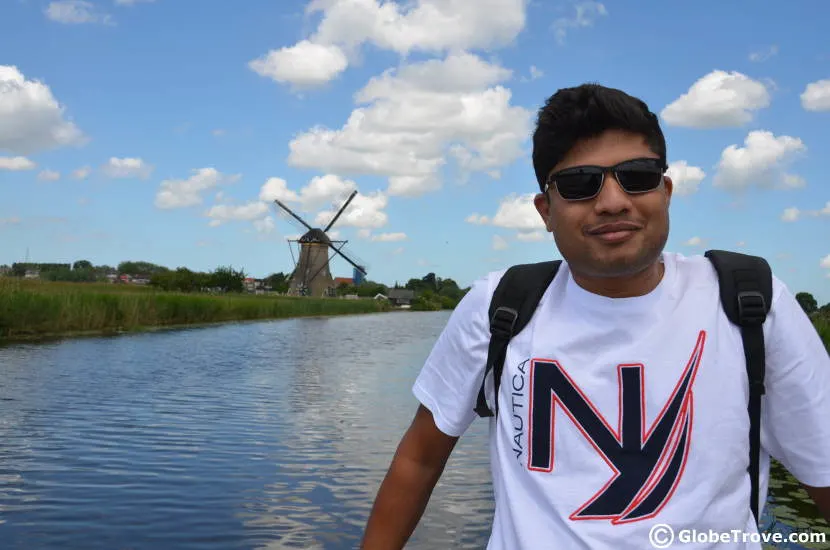
The clear blue skies and the windmills make an amazing backdrop for photographs.
The legend of Kinderdijk revolves over a flood that took place in November 1421. A storm beat down in the middle of the night raising the water levels of the river. The dykes collapsed, and the water swept in to submerge Kinderdijk claiming the lives of thousands of people. When the storm subsided, and the people came out, they found a baby in the basket.
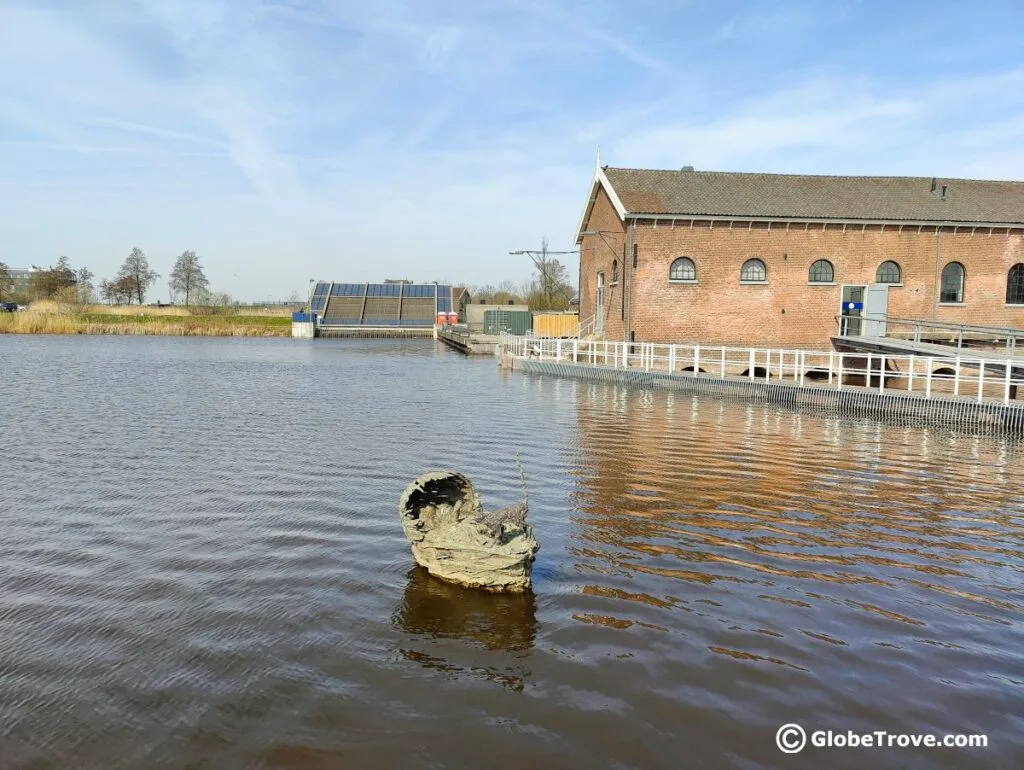
The cat, the baby and the basket at Kinderdijk.
Legend says that the baby would not have survived if it had not been for the cat that rocked the basket to and fro. The rocking motion kept the basket balanced in the midst of the natural calamity. People say that the legend gave Kinderdijk its name. You see ‘Kind’ in Dutch means ‘Child’ and ‘Dijk’ is ‘Dyke’.
Museum Windmill Nederwaard
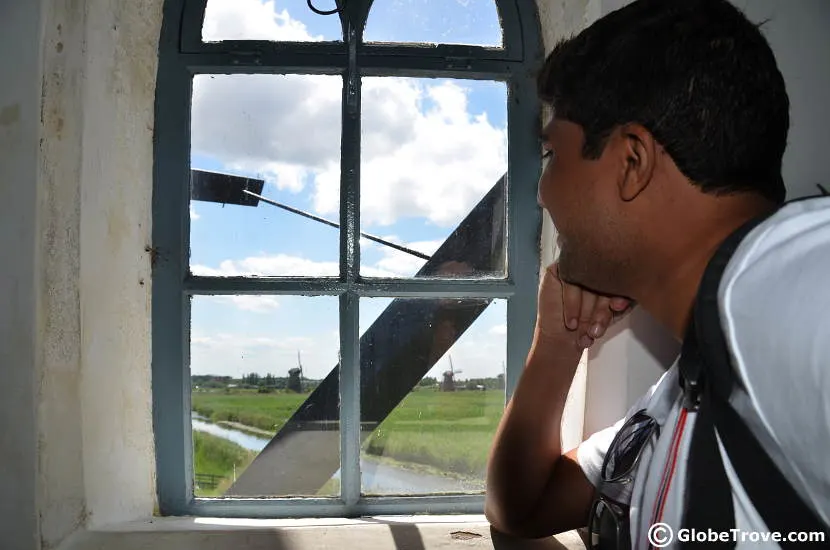
A view from inside the museum.
You walk through beautiful green meadows to reach the Museum Windmill Nederwaard. It was the first windmill I had ever seen up close and it was definitely the first windmill that I had ever been in.
The Museum Windmill Nederwaard, gives you an idea of what the life conditions of the initial settlers was. Their clothes and the sizes of the beds definitely shows that they were much shorter than the average Dutch person today.
Heating the entire windmill was impossible. That’s why the entire family would hunker down in a tiny room where the stove was located in. The stove served to cook their food and keep the tiny room warm.
Climb up the stairs to see the rotating parts of the windmill in action. The views from above are spectacular. The steps are steep and narrow so watch your step!
Museum Windmill Blokweer
The Museum Windmill Blokweer displays a different type of windmill architecturally. This one has a larger base which is homelier than the previous one. There aren’t steps leading up to the top. It is a quaint little stop as you wander through the area.
We had so many options on our plate to choose from when it came to visiting the Netherlands. We picked the windmills at Kinderdijk as our first spot. It’s a decision that I never regretted.
The site is as symbolic as it is beautiful. It tells of a story when man worked with nature to strike a balance. Life was not easy for the initial Dutch settlers but just because it was difficult did not mean that they gave up.
They persevered, the experimented and they perfected concepts in water management that are used around the world today. Aside from the history, Kinderdijk has beauty, peace and it makes you feel the strong connection that man needs to have with the natural environment.
Trekking Through The Dutch Countryside
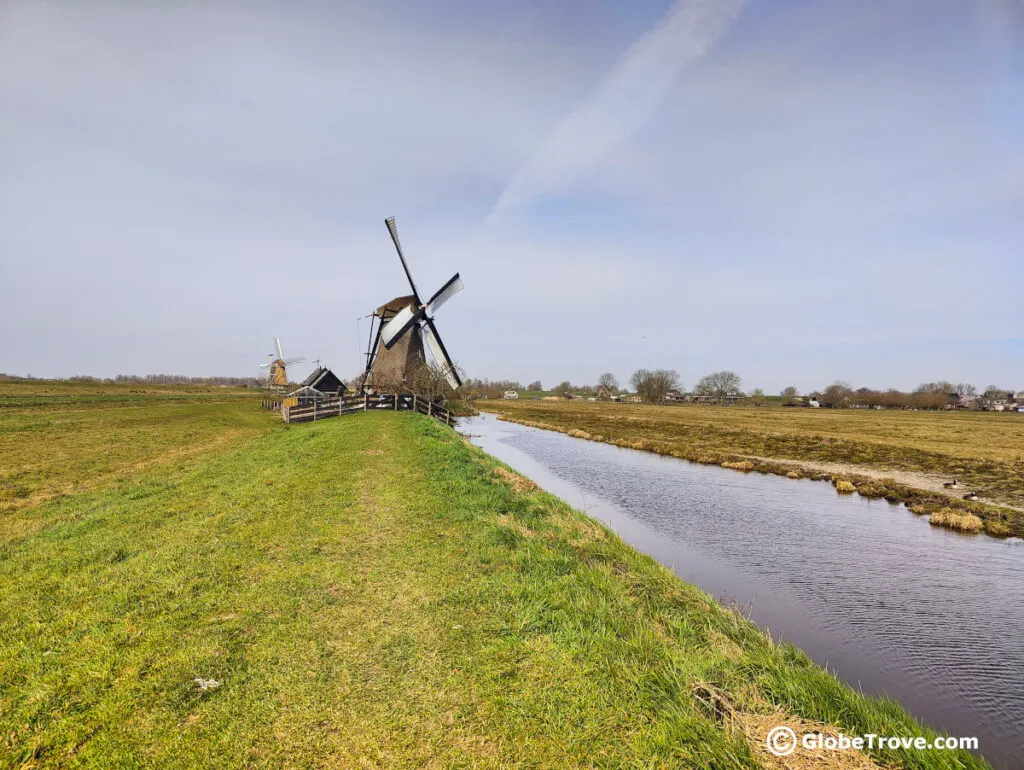
Recently we headed out on a short trek through the countryside with our friends. The trail was a little over 7 kilometers and was super easy. Its not just that we are used to walking but my 5 year old managed to do it with a few stops on the way. We did prop her up on our shoulders in between because we were walking at a faster pace. Our 4 year old managed to do about half of it which was also good.
Its a pretty laid back route which takes you through the canals and you can see the iconic Kinderdijk windmills along the way. Once you pass the windmills, you can catch a glimpse of some of the countryside. There are a lot of other longer routes. I find that Alltrails is a great place to check out the routes and the Kinderdijk trails are particularly interesting.
Tours To Kinderdijk From Different Cities In The Netherlands
The first time that we visited Kinderdijk, it was from Den Haag. The second time we drove down all the way from Groningen which is probably as far from it as you can go in the Netherlands. So if you really want to visit the UNESCO site, its possible and still totally worth it.
Now for those of you who aren’t lucky enough to have your own mode of transport and don’t want to depend on public transportation, these tours offer you great connectivity from different cities. Some even combine it with visits to places like Delft which is rather convenient.
From Amsterdam
- Kinderdijk and the Hague with museums
- Kinderdijk, Euromast, Delft and the Hague
- Kinderdijk, Delft and Mauritshaus
From Rotterdam
- Rotterdam and Kinderdijk walking and boat tour
- Kinderdijk, Delft City & Delft Blue factory visit
- Kinderdijk, Delft and The Hague (Private Tour)
- Kinderdijk, Gouda and Castle(Private Tour)
Visiting Kinderdijk – Frequently Asked Questions
How Far Is Kinderdijk From Amsterdam?
No matter how you look at it, Kinderdijk is a distance away from Amsterdam. Luckily transportation in the country is pretty easy to find. The average distance by car from Amsterdam is 106 km and it takes an hour and 42 min to make the journey. Note this is a pretty approximate idea because it depends on what time you leave and from which part of the city you leave.
The public transport will take you about two hours to cover the entire distance. Note that you will not have a direct connection throughout.
Do You Need Tickets For Kinderdijk?
Yes. There is a charge for visiting the Kinderdijk windmills. You can buy your tickets for Kinderdijk online or you could choose to buy them onsite. Buying them online saves a lot of time if there is a rush.
What Is Better: Zaanse Schans Or Kinderdijk?
Both Zaanse Schans and Kinderdijk are beautiful so it really is hard to compare. I personally love Kinderdijk because it is further away from the capital and the crowds. Not everyone chooses Kinderdijk as one of their day trips from Amsterdam because Zaanse Schans is more easily accessible. This usually means less crowds.
As you can see, Kinderdijk is one amazing trip. I usually advice combining it with a day in Rotterdam. That way you can see the best of both parts and make the most of your time.
Have you visited the windmills at Kinderdijk? What was your experience like? Let us know in the comments below.
If you are headed to Amsterdam, don’t forget to check out our top 10 things to do in the city and our food guides.
Other Posts On The Netherlands
- What to wear in the Netherlands
- Epic hotels in Amsterdam for every budget
- Giethoorn boat rentals
- Amsterdam tulip tours that you should consider
- How to get from Amsterdam to Keukenhof like a local
Don’t Forget To Pin This Post
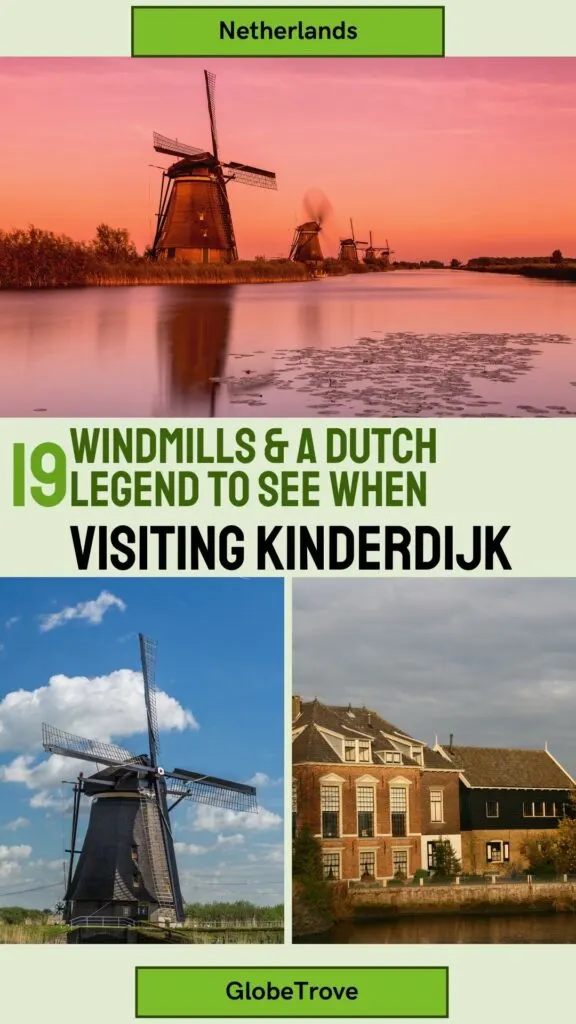
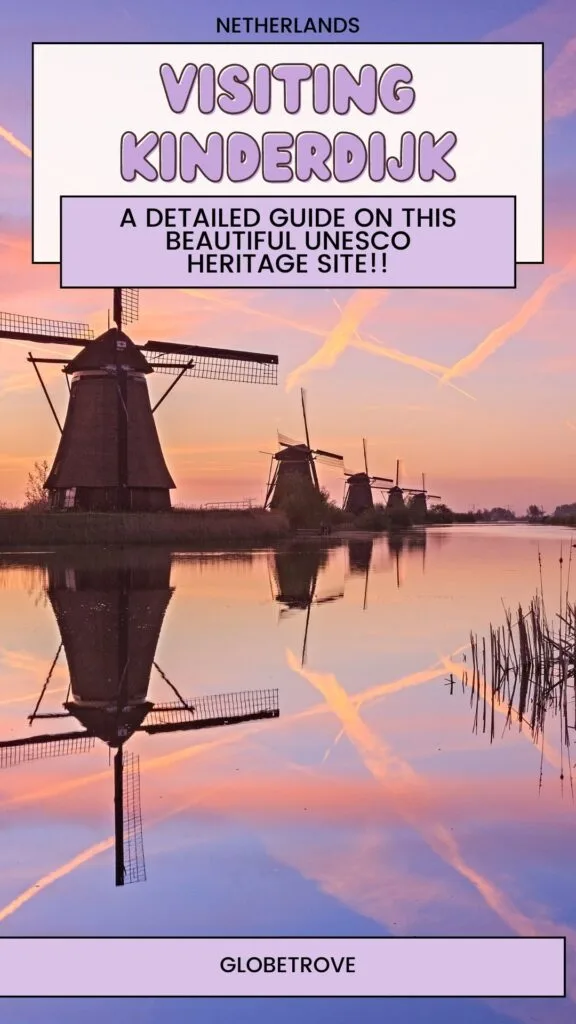
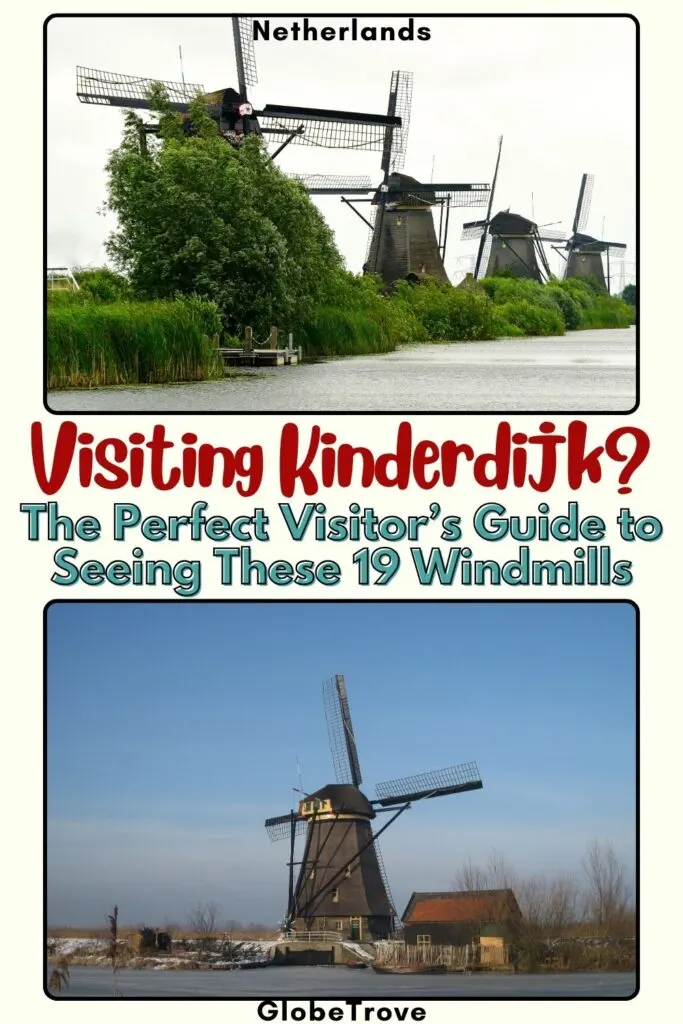
*This post contains Affiliate links

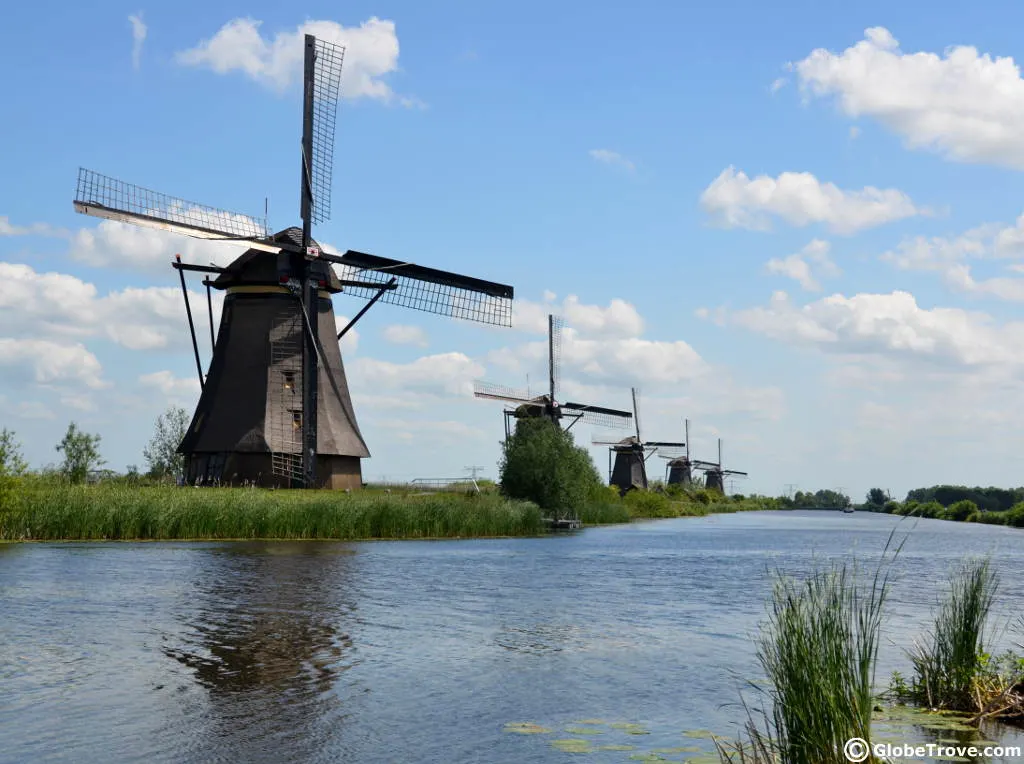
Janine Good
Thursday 8th of February 2018
The Netherlands are a treasure trove of sights and amazing things to do. Windmills are a symbol of the region and you got to see many of the vintage ones that haven't been replaced. Beautiful.
Eve
Thursday 8th of February 2018
Yay. This is one of my favorite things about the Netherlands. I loved the views that include windmills. I've been to Kinderdijk twice. Lovely place :)
Penny
Sunday 18th of February 2018
I can't wait to visit again. It is so peaceful and serene. It literally beckons you over.
Martha
Thursday 8th of February 2018
This is the picturesque view that everyone assumes is all of the Netherlands. And it really doesn't disappoint. Great photos you took of the historic windmills and great information about the historic site. This is definitely on my bucket list!
Penny
Sunday 18th of February 2018
I couldn't agree with you more. People often assume that Netherlands is all about windmills. There is much more to the country. That being said, the windmills never fail to disappoint and dI think Kinderdijk is the best place to catch a glimpse of them.
ARI
Thursday 8th of February 2018
These windmills on a sunny Dutch day are absolutely stunning. I enjoyed getting out of busy and bike-filled Amsterdam even if just for a few hours to see a bit more of the country, and a calmer region. It's amazing what they were able to do with Windmills back in the day, just inspiring!
Penny
Sunday 18th of February 2018
Amsterdam has all the hustle and bustle. I feel sad that more people don't step out to see the Dutch countryside. It is beautiful and so laid back. I can't wait to go back.
Laura @ TTS
Thursday 8th of February 2018
I've visited somewhere similar near to Keukenhof and it's so awesome to learn more about these windmills. Such a lovely day out and they're so picturesque! I'd love to go back and explore more of The Netherlands.
Penny
Sunday 18th of February 2018
I wanted to visit Keukenhof. Unfortunately I arrived a week to late. That however just gives me more reasons to head back to Netherlands. :)